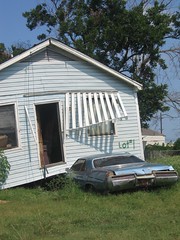
incompatible
Originally uploaded by pix4lita.
Robin Kear of Nova Southeastern University has some great photos of the New Orleans 9th Ward. Here’s the story:
When I met local writer and tour operator Rob Florence in the Jean Lefitte bar on the less-busy end of Bourbon, I wasn’t sure if he was trying to pull a hustle. Two librarian colleauges and I went there to have a Sazerac late Thursday night and a couple of locals bought them for us. We reciprocated some time later and met Rob and a good friend of his. Most of the conversation revolved around the annihilation caused by Katrina. Rob offered to take us around all of the canal breaches and into the lower ninth ward the next morning to see it for ourselves. Fortunately, it wasn’t a hustle.
As Rob drove us past street after street after street of abandoned houses in the Lakevue, Gentilly, and Elysian Fields, his disgust and rage were palpaple. Rage against the politization of an event that should be above it. Rage at the friends and community he has lost due to suicide, alcohol, and dispersement. Disgust at an event that could have been prevented and was predicted. Sadness that America seemed to be forgetting and that it will take a decade to return to normalcy. Rage that recovery is slow and federal money is even slower in coming. The French Quarter and the Business District have survived and locals need that life-blood, energy and revenue to keep going.
The one thing that you don’t realize about the devastation when you are outside New Orleans is the size. You can drive for miles among thousands and thousands of homes that are destroyed and/or uninhabitable. Each home is a family, an investment, a dream, a happiness; a link in the community chain that has disappeared.
When Rob took us to the devastation caused by the Industrial Canal breach in the lower Ninth Ward, he commented that there should be a thousand people a day witnessing the event, “There should be tour bus after tour bus driving around with thousands of people, so we don’t forget. People don’t go to Holocaust camps because they are morbid; they go so that we don’t forget.” The force of the water destroyed homes, lives, and part of a culture. I was mentally fatigued after one hour of driving around the destroyed landscape; I cannot imagine living hour after hour, week after week in a nightmare that doesn’t end.
It will never be the same. It will be a different city. Time and lives will be measured by pre-Katrina and post-Katrina. I am glad that ALA chose to stay here because as Leonard Kniffel said in American Libraries librarians make great witnesses. Thank you to a New Orleanian who personally made three.
Robin Kear